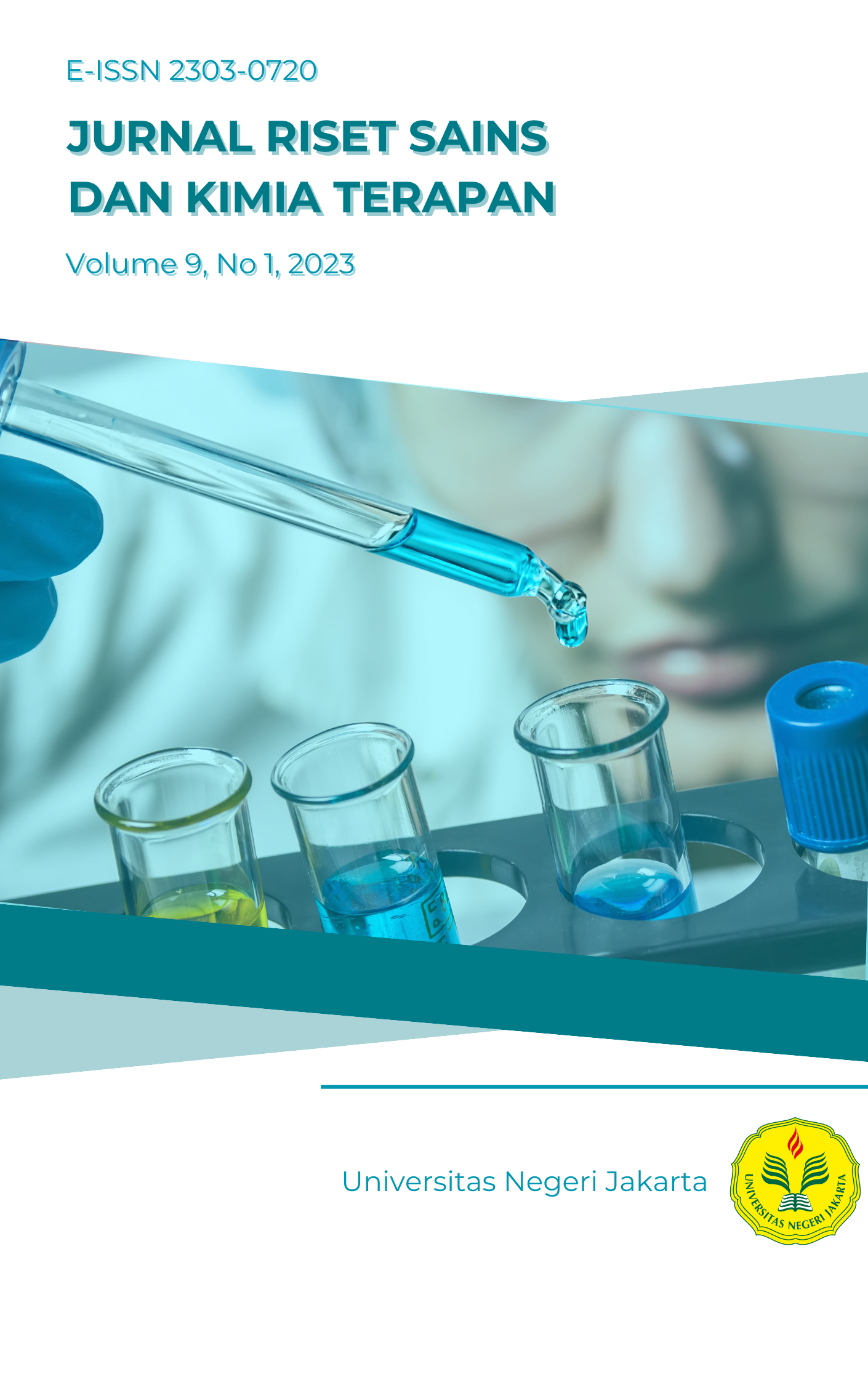Analisis Kadar Chemical Oxygen Demand (Cod) pada Air Limbah Domestik dengan Metode Refluks menggunakan Spektrofotometer Uv-Vis
DOI:
https://doi.org/10.21009/JRSKT.101.06Keywords:
air limbah domestik, COD, spektrofotometer UV-VisAbstract
Abstrak
Air merupakan komponen vital bagi kelangsungan makhluk hidup. Dengan perkembangan sektor industri, seringkali terjadi pencemaran lingkungan perairan akibat limbah cair. Limbah cair tersebut berasal dari berbagai aktivitas seperti pemukiman, industri, dan perkantoran. Air yang tercemar, dapat menimbulkan penurunan kualitas air. Air yang memiliki kualitas yang tidak baik, dapat menimbulkan resiko berbagai penyakit dan tentunya dapat merusak sumber daya alam dan lingkungan. Salah satu upaya ntuk menjaga lingkungan, mengidentifikasi kualitas air limbah guna mengetahui tingkat bahayanya. Dalam mengidentifikasi kualitasi air limbah, diperlukan metode yang dapat mengidentifikasi dan mengurangi resiko dalam kerusakan lingkungan. Pengujian Chemical Oxygen Demand (COD) dalam air limbah dilakukan dengan menggunakan metode refluks dengan menggunakan Spektrofotometer UV-Vis sesuai dengan Standar Nasional Indonesia (SNI) 6989.2:2019. Proses pengujian yang dilakukan yaitu menggunakan sampe air limbah domestik yang dilarutkan bersama dengan larutan pencerna konsentrasi tinggi, larutan pencerna konsentrasi rendah (low digestion solution), larutan pereaksi asam sulfat, asam sulfamat (NH2SO3H), dan larutan standar kalium hidrogen phlatat (KHP). Hasil pengujian menunjukkan bahwa kadar COD memenuhi persyaratan yang telah ditetapkan, berada di bawah nilai batas maksimum yang ditetapkan oleh Peraturan Menteri Lingkungan Hidup dan Kehutanan Nomor P.68/MENLHK/SETJEN/KUM.1/8/2016.
Kata kunci: air limbah domestik, COD, spektrofotometer UV-Vis
Abstract
Water is a crucial component for the survival of living things. With the development of the industrial sector, there is often pollution of the aquatic environment due to liquid waste. The liquid waste comes from various activities such as settlements, industries, and offices. Polluted water can cause a decrease in water quality. Water that has poor quality can pose a risk of various diseases and of course can damage natural resources and the environment. One of the efforts to protect the environment is to identify the quality of wastewater to determine the level of danger. In identifying the quality of wastewater, a method is needed that can identify and reduce the risk of environmental damage. Chemical Oxygen Demand (COD) testing in wastewater is carried out using the reflux method using a UV-Vis Spectrophotometer in accordance with Indonesian National Standard (SNI) 6989.2: 2019. The testing process carried out is using domestic wastewater samples which are dissolved together with high concentration digestion solution, low concentration digestion solution (low digestion solution), sulfuric acid reagent solution, sulfamic acid (NH2SO3H), and potassium hydrogen phlatate (KHP) standard solution. The test results show that COD levels meet the predetermined requirements, being below the maximum limit value set by the Minister of Environment and Forestry Regulation No. P.68/MENLHK/SETJEN/KUM.1/8/2016.
Keywords: COD, domestic sewage spectrophotometry UV-Vis
References
Cheng, P., Li, X., Su, J., & Hao, S. (2018). Recent water quality trends in a typical semi-arid river with a sharp decrease in streamflow and construction of sewage treatment plants. Environmental Research Letters, 13(1), 014026. https://doi.org/10.1088/1748-9326/aa9df2
Duan, W., del Campo, F. J., Gich, M., & Fernández-Sánchez, C. (2022). In-field one-step measurement of dissolved chemical oxygen demand with an integrated screen-printed electrochemical sensor. Sensors and Actuators B: Chemical, 369, 132304. https://doi.org/10.1016/j.snb.2022.132304
Han, X., Chen, X., Ma, J., Chen, J., Xie, B., Yin, W., Yang, Y., Jia, W., Xie, D., & Huang, F. (2022). Discrimination of Chemical Oxygen Demand Pollution in Surface Water Based on Visible Near-Infrared Spectroscopy. Water, 14(19), 3003. https://doi.org/10.3390/w14193003
Jain, N. (2023). Water Pollution due to Industrial Waste Effluents and their Management. International Journal for Multidisciplinary Research, 5(1). https://doi.org/10.36948/ijfmr.2023.v05i01.1608
Jiang, L., Feely, R. A., Wanninkhof, R., Greeley, D., Barbero, L., Alin, S. R., Carter, B. R., Pierrot, D., Featherstone, C. M., Hooper, J. A., Melrose, C., Monacci, N., Sharp, J. D., Shellito, S., Xu, Y., Kozyr, A., Byrne, R. H., Cai, W., Cross, J. N., & Johnson, G. C. (2021). Coastal Ocean Data Analysis Product in North America (CODAP-NA) – an internally consistent data product for discrete inorganic carbon, oxygen, and nutrients on the North American ocean margins. Earth System Science Data, 13(6), 2777–2799. https://doi.org/10.5194/essd-13-2777-2021
Lambertz, S., Franke, M., Stelter, M., & Braeutigam, P. (2023). Sensing of chemical oxygen demand (COD) by amperometric detection—dependence of current signal on concentration and type of organic species. Environmental Monitoring and Assessment, 195(6). https://doi.org/10.1007/s10661-023-11228-3
Lemessa, F., Simane, B., Seyoum, A., & Gebresenbet, G. (2023). Assessment of the Impact of Industrial Wastewater on the Water Quality of Rivers around the Bole Lemi Industrial Park (BLIP), Ethiopia. Sustainability, 15(5), 4290–4290. https://doi.org/10.3390/su15054290
Mahmood, Q., Shaheen, S., Bilal, M., Tariq, M., Zeb, B. S., Ullah, Z., & Ali, A. (2019). Chemical pollutants from an industrial estate in Pakistan: a threat to environmental sustainability. Applied Water Science, 9(3). https://doi.org/10.1007/s13201-019-0920-1
Nishat, A., Yusuf, M., Qadir, A., Ezaier, Y., Vambol, V., Khan, M. I., Moussa, S. B., Kamyab, H., Sehgal, S. S., Prakash, C., Yang, H.-H., Ibrahim, H., & Eldin, S. M. (2023). Wastewater treatment: A short assessment on available techniques. Alexandria Engineering Journal, 76, 505–516. https://doi.org/10.1016/j.aej.2023.06.054
Ramadhan, I., Rohyami, Y., & Ahdiaty, R. (2022). Verifikasi Metode Uji COD secara Spektrofotometri UV-Vis untuk Low Concentration dan High Concentration. IJCA (Indonesian Journal of Chemical Analysis), 5(1), 52–61. https://doi.org/10.20885/ijca.vol5.iss1.art6
Tang, L., Chen, Y., Peng, J., & Cheng, Z. (2023). Influence of Different Industrial Waste Residues on Engineering Properties of High Liquid Limit Soil and Its Microscopic Mechanism. Buildings, 13(1), 235–235. https://doi.org/10.3390/buildings13010235
Wiesner-Sękala, M., & Kończak, B. (2023). Assessment of the Impact of Industrial and Municipal Discharges on the Surface Water Body Status (Poland). Sustainability, 15(2), 997–997. https://doi.org/10.3390/su15020997
Wiryawan, B. A., & Otchia, C. (2022). The legacy of the reformasi: the role of local government spending on industrial development in a decentralized Indonesia. Journal of Economic Structures, 11(1). https://doi.org/10.1186/s40008-022-00262-y
Xia, Q., Zhang, J., Chen, Y., Ma, Q., Peng, J., Rong, G., Tong, Z., & Liu, X. (2020). Pollution, Sources and Human Health Risk Assessment of Potentially Toxic Elements in Different Land Use Types under the Background of Industrial Cities. Sustainability, 12(5), 2121. https://doi.org/10.3390/su12052121
Xu, X., Wang, J., Li, J., Fan, A., Zhang, Y., Xu, C., Qin, H., Feng, M., & Xu, T. (2023). Research on COD measurement method based on UV-Vis absorption spectra of transmissive and reflective detection systems. Frontiers in Environmental Science, 11. https://doi.org/10.3389/fenvs.2023.1175363
Zioui, D., Martins, P. M., Aoudjit, L., Salazar, H., & Lanceros-Méndez, S. (2023). Wastewater Treatment of Real Effluents by Microfiltration Using Poly(vinylidene fluoride–hexafluoropropylene) Membranes. Polymers, 15(5), 1143. https://doi.org/10.3390/polym15051143







